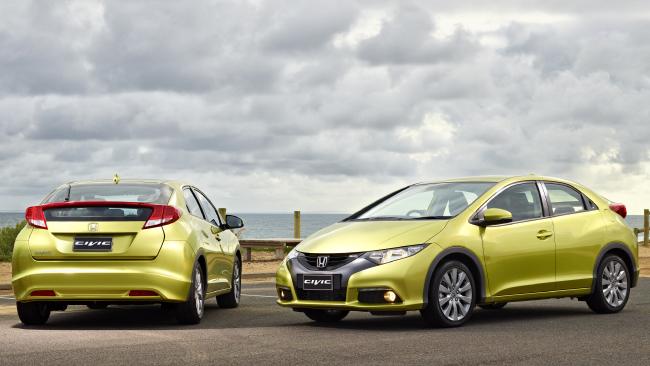Solid all-rounder: Honda’s 2012 Civic hatchback.Source:Supplied
Millions of car owners can’t be wrong: globally we’ve bought 23 million Honda Civics, with more than 300,000 of those finding Australian homes since 1973. It’s a nameplate that inspires loyalty, as indicated by strong sales of the latest 10th generation Civic, which arrived in 2016.
The used market has a glut of 2012-16 ninth generation Civics as loyalists upgrade, and these hatches and sedans remain a solid buy for those who favour all-round competence and reliability over thrills and fanciness.

Popular appeal: Honda has sold more than 300,000 Civics in Australia since the 1970s.Source:Supplied
When the current (very impressive) Civic was launched, Honda fronted up and admitted it had stood still in recent years, meaning the previous generation Civics were somewhat bland and lacked some of the safety and technology advances of key small car rivals.
But Honda still knew how to make a good car. It proved well made, comfortable, the engines were refined and reliable and its practicality and boot space were excellent for the segment.
The Civic model range was huge and a bit confusing. Hatchbacks looked and sold better than the four-door sedan; there were two different petrol engines, a hybrid and a turbo diesel, although the latter two didn’t sell well.
The hybrid Civics were expensive, had a smaller boot (351L v 440L) and didn’t offer huge fuel savings, so wouldn’t be the first choice on the used market.

The ninth generation Civic was well made and comfortable.Source:News Limited
The diesel however is a good target, although they were only sold with a six-speed manual gearbox. Incredibly frugal, a more rewarding engine than the petrol counterparts and better value. There aren’t many out there but they’re worth hunting down if you travel lots of kilometres each year.
Initially, the sedan came in only three variants, the VTi-L (104kW 1.8-litre) and Sport (114kW 2.0-litre) and hybrid (82kW 1.5-litre petrol-electric). The VTi-L had a five-speed manual or five-speed automatic, the Sport was auto only and the hybrid had a less than brilliant constantly variable transmission.
Standard equipment included alloy wheels, five-inch colour multi-info display, auto climate control, cruise control, Bluetooth with audio streaming, iPod connectivity and steering wheel controls. Lacking were reversing camera and auto emergency braking.
Sport models scored leather seats, auto headlights and wipers and power sunroof.
Within months, the pricier British-built hatch arrived (the sedan came from Thailand and the hybrid from Japan) with the 1.8-litre, in VTi-S and auto-only VTi-L trim. Honda’s “magic” seating was a highlight — the rear seat bases smartly folded up to give excellent tall load space in the back.

Honda sold fewer diesel Civics but they’re lack of thirst makes them appealing.Source:Supplied
The spec of the entry-level hatch didn’t match the sedan’s. It missed out on auto climate control and cruise control but the VTi-L scored heated leather seats and reverse camera.
July 2012 marked the arrival of the sedan Series II, with a cheapie steel-wheeled VTi model, and navigation and reverse camera-equipped VTi-LN added to the range.
For the 2013 hatch range, a VTi-LN arrived with satnav, while the rest gained cruise control and reverse camera as standard.
In April 2013 the DTi-S diesel hatch launched with ultra-thrifty claimed thirst of 4.0L/100km, 17-inch alloys, reverse camera and cruise control. Lack of an auto option stunted sales but the six-speed manual was a gem.
Slow sales meant prices dropped and specification was slightly improved in the sedan by October 2013, while nine months later even more minor spec improvements came — along with the super cheap Vi — to try to boost sales.
In April 2014, it was the turn of the hatch to drop the price and it got a minor facelift. To confuse matters further, a year later there was yet another facelift — new bumpers and grille, daytime running lights and phone-mirroring screen arrived, as did parking sensors for the two top grades.

The hybrid didn’t offer huge fuel savings.Source:Supplied
Across the range, cabin plastics were hard but the interior was well screwed together. It garnered praise for practical cargo space, specifically in the hatch.
The drive was comfortable and assured but never thrilling, with the common 1.8-litre engine struggling for any real urge.
WHAT TO LOOK FOR
Honda has built a loyal following due to mechanical reliability.
The biggest red flag is the brakes, specifically the rears on the hatch. Many owners have reported these wear out prematurely. If you can find a used example with its brake rotors and pads recently replaced, that’s a positive.
Other grumbles are lots of brake dust on the alloys, the front end bottoming out easily (check underside damage hasn’t amounted to more than bumper scratches), plus the odd dash rattle and gremlins in the display screen.
Many Civics of this generation will be out of warranty, as they came only with three-year/ 100,000km coverage. Service intervals are rather inconvenient at six months/10,000km.
IAIN SAYS 2.5 STARS
The quality of the current Civic underscores the ordinariness of the previous series. The Hondas may be uninspiring but they remain solid all-rounders, the hatch being the better variant. Early brake wear is a costly concern.

This generation of Civics lacked some of the safety and technology advances of small car rivals.Source:Supplied
OWNERS SAY
Leanne Clarke: I’ve had my 2013 hatch since new and the most important thing has been reliability. It’s never let me down. The automatic gearbox can be a bit jerky when first engaged. I love its boot space, practicality and the magic seats. It still feels like new.
William Henriksen: We bought a 2014 VTi-L hatch as a second car. It’s a great town run-around and I think it looks fantastic. Good points are its fuel economy and it’s comfy and quiet, though it feels unresponsive and slow compared to our Hyundai Tucson.
Michael Wilson: I love the look of my 2012 VTi-S. It’s very economical but the brakes are European. I didn’t like replacing the brake pads at only 21,000km.
THE EXPERTS SAY
For the ninth generation Civic, Honda tallied about 38,000 sales in Australia, hatches and sedans combined. Virtually all of the used examples for sale are petrol versions, four out of five are automatics and British-built hatches account for the majority.
The popular variants are the VTi-L and VTi-S, which when combined represent nearly three-quarters of used-car stock. Silver, grey and white are the most popular colours. The base-grade Vi from 2014 seems generally unloved by used buyers.
Conventional models retain value better than hybrids. The base VTi-L manual sedan from 2012 ($20,990 new) is $11,800 for a vehicle in good condition having covered 15,000km a year. The contemporary range-topper, the Sport auto sedan ($27,990 new) fetches $15,700. Resale prices for 2016 models are $15,800 for Vi manual sedan ($18,490 new) and $26,500 for the VTi-LN auto hatch ($31,090 new).
The Civic from 2012 holds its value better in the case of the hatch than the sedan and leads the Mazda3, the Hyundai i30, Toyota Corolla, Volkswagen Golf, Ford Focus and Holden Cruze, in that order. For the final year on sale, 2016, the Series II Civic’s resale values remained competitive but not segment-leading.
AT A GLANCE
PRICE NEW $18,490-$35,990
SAFETY 5 stars
ENGINE 1.8-litre 4-cyl, 104kW/174Nm;
2.0-litre 4-cyl, 114kW/190Nm;
1.5-litre 4-cyl hybrid, 82kW/172Nm;
1.6-litre 4-cyl turbo diesel, 88kW/300Nm
TRANSMISSION
5 and 6-speed man, 5-speed auto, CVT; FWD
THIRST 4.0L-7.5L/100km
[“Source-news”]






